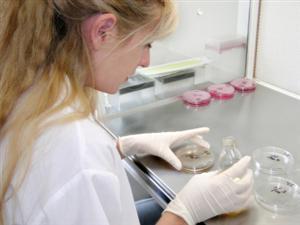| Complexity level: | 5 |
| Project cost ($): | 20 |
| Time required: | 1 day to prepare, 3 days for experiment |
| Material availability: | Easily found |
| Safety concerns: | The bacteria should be destroyed before it is disposed of. Pour some bleach into the petri dish to kill all the bacteria before disposing in the trash. |
Hypothesis
Baby food will become more contaminated when it is left out for a longer period of time.
Overview
Food poisoning
Food poisoning happens when we eat food that has gone bad. This food will have bacteria growing on it and it will smell bad. If we continue to eat it anyway, we will experience stomach pain, diarrhea and vomiting amongst other symptoms. Some types of bacteria commonly found in food are Escherichia coli, Listeria, Salmonella and Campylobacter.
Bacteria can be found in the environment all around us. Some of the bacteria is good for us but most of the bacteria found in food that has gone bad are harmful.
Food contamination
The presence of harmful substances like bacteria and chemicals in our food can lead to food poisoning. Carefully documented procedures are followed by food manufacturers to minimize the contamination of food by preparing and packing them in a sterilized environment. However, when we bring this food back to our homes and open them for consumption, the bacteria and other microbes in our surroundings come in contact with the food and lead to contamination. This is why canned and bottled food must be consumed as soon as possible, once opened.
Scientific Terms
Materials
The materials required for this experiment:
- 9 petri dishes prepared with blood agar
- 3 bottles of chicken baby food
- 3 bottles of pumpkin baby food
- 3 bottles of apple baby food
- A refrigerator
- 9 sterile cotton buds
- 1 permanent marker pen
Procedure
- For this experiment, the independent variable is the type of baby food (chicken vs. pumpkin vs. apple) and the amount of time the food is left out the refrigerator. The dependent variable is the rate of growth of the bacteria colony. This is determined by measuring the size of the colony using a ruler. The constants (control variables) are the room temperature, the brand of each type of baby food, the amount of sunlight exposure and the ingredients used in the preparation of the petri dish agar.
- The petri dish prepared with the blood agar must be stored in a refrigerator. Before the start of the experiment, remove the petri dish from the refrigerator to allow it to normalize at room temperature.
- The 3 bottles from each type of baby food are labeled A, B and C
- Chicken A
- Chicken B
- Chicken C
- Pumpkin A
- Pumpkin B
- Pumpkin C
- Apple A
- Apple B
- Apple C
- The 3 types of bottles marked A are opened briefly, then covered/closed. Following this, the bottles are immediately stored in the refrigerator for 24 hours.
- The 3 bottles marked B are opened and kept out of the refrigerator for 30 minutes before replacing the cap. Following this, the bottles are immediately stored in the refrigerator for 24 hours.
- The 3 bottles marked C are opened and kept out of the refrigerator for 30 minutes before replacing the cap and it is then left out of the refrigerator for another 24 hours.
- After the 24 hour incubation period, mark the Petri dishes according to the list provided in step 3.
- Remove the petri dish lids and using sterile cotton buds, take a small swab sample from each bottle (from at least 3 different spots within the bottle) and place it in the center of the relevant Petri dish (i.e. chicken sample from bottle A will be placed in petri dish marked Chicken A). A new cotton bud must be used to collect the swab from each bottle.
- Replace the petri dish lid and store the Petri dishes in a cool, shaded place.
- The diameter of the bacteria colony is measured after 3 days and recorded in the below table.

Results
The results show that the specimen that was left outside for 24 hours had the highest rate of bacteria growth. The specimen that was opened and left outside for 30 minutes had the second highest rate of bacterial growth and the specimen that was immediately placed in the refrigerator had the least bacterial growth. The chicken specimen had a larger bacteria colony then the pumpkin and apple specimens.

Use the graph below to plot the results of the table above.
Conclusion
The hypothesis that baby food will become more contaminated when it is left out of the refridgerator for a longer period of time, is proven to be true.
It's interesting to note tthat meat products become contaminated much faster than vegetable or fruit products.
Babies have weak immunity systems and are more susceptible to food poisoning due to bacterial growth in their food. In addition, they do not have the ability to vocalize if they are experiencing stomach pains or nausea. Hence, extra care must be taken to prevent baby food from getting infected. Once a bottle of baby food is opened, it is best to consume the food as soon as possible. That's not just a ploy by food manufacturers to get you to buy more baby food - as you have observed from our experiment, bacterial growth in baby food is a very real threat.
Also consider
The experiment can be repeated by using different brands of baby food.
Try to repeat the experiment using milk, porridge and soup. Also modify the experiment by dipping a used spoon (containing baby saliva) into the bottles of food, and observe if there is any difference in your results.
References
Food poisoning - http://kidshealth.org/PageManager.jsp?dndsHealth&lic
Food contaminants - http://en.wikipedia.org/wiki/Food_contaminants

